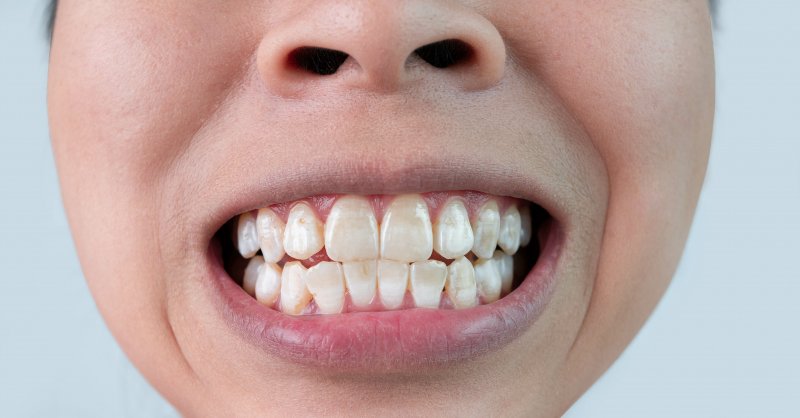
Like most people, you probably think all tooth stains are the same. After all, aren’t they caused by the same issues, even if they differ a bit in color? However, the truth is quite the opposite: There are three types of tooth stains, each with unique causes. Therefore, you need to know their differences to get proper treatment. Luckily, your San Diego dentist is here to help you. Read on to learn about different tooth stains and how to remove them.
What are the Types of Tooth Stains?
In general, tooth stains come in three types: extrinsic, intrinsic, and age-related. Each has its own causes, meaning they often benefit from different treatments. Consider the factors listed below:
Extrinsic Stains
Extrinsic tooth stains occur on your teeth’s surface layer. In other words, they only reach your pearly whites’ enamel.
The most common causes of this stain type are residues from foods, drinks, or tobacco.
Intrinsic Stains
In contrast to extrinsic ones, intrinsic stains happen beneath a tooth’s surface. As a result, they tend to look grayish rather than yellow or brown.
Intrinsic stains can stem from medications, tooth trauma, tooth decay, excess fluoride, and genetics.
Age-Related Stains
Age-related tooth stains combine aspects of both intrinsic and extrinsic tooth staining.
You see, enamel naturally wears away as you age. Plus, the dentin underneath it yellows too. Consequently, your teeth can appear yellowish once you reach your senior years. This effect can get worse when you eat tooth-staining foods and drinks.
How Can a Dentist Treat These Stains?
Depending on which tooth stains you have, you could benefit from one (or more) of the following treatments:
- At-Home Teeth Whitening: Since it works by bleaching enamel white, at-home whitening is best for those with extrinsic stains. Wearing its special trays for 15-20 minutes daily over two weeks can make your pearly whites 6-8 shades whiter!
- Cosmetic Dental Bonding: For this procedure, your dentist covers up smile flaws with a composite, tooth-colored resin. As such, dental bonding is excellent at handling intrinsic stains below your enamel.
- Porcelain Veneers: Like dental bonding, veneers cover smile flaws rather than erase them. However, they do so with layers of ceramic rather than resin. They’re thus ideal for patients who have a smattering of intrinsic and age-related tooth stains.
Even if you have stained teeth, you don’t have to live with them. Talk to your local dentist about possible treatment options in the coming days.
About the Author
Dr. Nelson Howard is a dentist based in San Diego, CA, having earned his DDS from the UCLA School of Dentistry. He is also the first dentist in North San Diego County to become an Accredited Member of the American Academy of Cosmetic Dentistry. In his work, he specializes in preventive, cosmetic, and restorative dental treatments, including emergency procedures. Dr. Howard currently practices at his self-titled clinic and can be reached at his website or by phone at (858)-451-0550.
